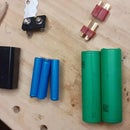Introduction: Scooter With Dual Suspension
Before starting let me just say it is a lot less hassle to buy a ready made scooter and their are some nice ones. That being said if you like to build things and customise stuff then this is up your alley.
Basically the whole thing started with my daughter and her scooter, she kept asking me to ride with her and the other scooter was one of those small hard wheeled things that I found kind of small and awkward. So the search began for an adult scooter - kind of expensive. So having some old bikes that I got from the dump (I was just keeping them to replace the gear shifter on my current bike) I decided to cut them down to make the scooter/kickbike.
Elements needed
1. 1 adult bike frame and front wheel and matching suspension fork.
2. 1 kids bike frame and front wheel with rear suspension link
3. Arc/stick welder and lots of rods if you are bad at welding
4. Grinder with disc for cutting metal + wire brush wheel to take paint off and clean welds
5. Metal clamps to hold pieces in place while welding.
6. All safety gear gloves, mask glasses etc
7. carbog and sander
8. 2 or 3 cans of spray + some nice stickers
9. Lots of time and patience
Step 1: What Type of Scooter Do You Want?
Work out what you want out of the scooter. From previous experience of skateboards I found the lower the base the better for kicking. After really looking and studying those great articles of homemade kickbikes here on instructables I embarked on the production sketches.
* Low base 8 to 10 cm
* Light as possible
* Use as much of the original bike frame as possible
* Close foot position to the front wheel/handlebars with good foot room
* Conserve steering angle of original bike
* Dual Suspension front + rear if possible.
Step 2: Dismantle the Frame
Pull out all the parts that are going to get in your way. Gears, cranks, brakes, cables, seat etc...
From there cutting down the frame becomes easier.
You want a steel bike frame they are easier than aluminum to weld. Also better for bending with heat.
Before cutting I spent lot of time thinking and looking at the original frame and what went where. Each frame is different so you have to adapt.
I stood the frame up with a wheel in place, the rear and put a board behind to trace the angles. Take a large drywall T square and set it upside down so that you can now roughly trace the mark of your ride height. Leave a littel bit extra of the downtube before you cut it. I was a fraction short myself. Then you can start thinking how you are putting it all together.
Lay the parts flat and start to position the elements.
I left as much of the original welds in place because I am terrible at welding thin metal, total novice.
To get the right angles I had to bend the 2nd part (originally the seat tube) of the frame.
Step 3: Welding Tips and Bending Metal
Welding
I am still getting to grips with welding but this is a good project to learn some things.
Take a look at Chucke2009 welding videos on youtube.
http://m.youtube.com/user/ChuckE2009
1. Make sure you clean the metal to be welded, I use a grinder with wire disc or drill with wire brush fitting for preparing before and for cleaning the slag after welding.
2. When welding clamp a piece of scrap near where you will weld.Use this to get your weld stick hot before doing your frame welds.
3. Bike frame tubing is pretty thin so be careful with weld settings or you will blow through the metal. If this happens try to add a piece of metal or nail or rod across the hole, can be held in place with some pliers while you weld. Getting the stick hot will allow you to reduce the amps on your welder and reduce the chance of blowing holes in the metal.
Bending the metal
A lot of heat is needed to bend the steel tube. I basically set my little blow torch in place and left it for 10min till the metal went orange, it was still tough to bend but using the seat pole as leverage it worked out.
Step 4: Workout the Cuts and the Positions
The frame was cut as previously shown.
The top tube went in the center of the foot plate
The seat tube and rear bottom wheel tubes were left together and welded to a shortened drop tube. This forms the new downtube to the footplate.
The upper wheel stays went back into reinforcement of the modified downtube.
Adjust the wheel as needed. I tried to tighten the wheelbase up to be more practical for both riding and transport.
Step 5: Weld Frame
I did a lot of dry laying out of the frame bits before welding this gives you a feel for the dimensions and what tube you can use and where.
1. The new downtube was heated and bent to get the angle this was repeated later when the final angles were tuned in.
2. The tube for the center of the foot board was coupled with the fitting for the back suspension arm.
3. I then added the flat steel plates to each end of the footboard. The plates are not too heavy and serve to join the 3 center pipes that form the support for the foot board.
5. I also just did some weld spots on top of the plates for grip they are only on the surface and serve no structural purpose.
Tips for Dual Suspension
1.The dual suspension part can be tricky. Its hard to determine the final ride height without standing on the platform so I did a few tack welds just to hold things in place until I stood on the scooter. Then I fixed the angles and welded them in their final position.
2. If your not strong on welding try and use the welds that are on the original bike frame..
3. Be prepared to change your frame design as you go, giving points that are under more stress more support.
4. The head angle looks vertical on the final picture but once a rider is standing on it the frame squats and the angle comes good. Watch out when you build scooters with or without suspension that have too much slant on the neck "chopper" style they tend flop into corners and are a little unpredictable.
Step 6: Tune Frame and Suspension
Rear wheel Mount and brake
I did some custom dropouts for the rear wheel so I could run different wheels on the back. Of course if you change wheels you need to reset the brake mounts.Get some brakes on the thing before you get too excited, I used the brake mounts from the doner bike and welded them in place.
The brake mounts need to be positioned as close as possible to the axis the axle is on.
Once you are confident that the scooter can stop and is solid enough to carry you and maybe a passenger without exploding on the driveway then you can do some custom work.
Extra Support
I used the left over bits from the back triangle to form the extra supports on the front end.
Step 7: Fine Tuning
The scooter as it is runs perfectly and I will be in the process of grinding down the ugly welds and tuning to make the scooter a little more flashy. So it should be updated in a couple of months.
My brother in law gave it a test ride and the frame snapped right in the middle of the lower downtube... so i rewelded, reinforced, and added a smaller downtube and gussett to the original. I also added the seatpole and did some of the fiddly bits like the rear mud guard that you fan stand on. The welding was a mess so opted for carbog/ bondo smoothing as shown. A custom spray and sticker job.
I have a few more mods to add but as you can see it looks pretty much fin7shed
1. foot pegs on front and rear wheels.
2. bmx handle bar and gooseneck to get a more upright rider position
Step 8:

Participated in the
Workshop Contest

Participated in the
Manly Crafts Contest

Participated in the
Instructables Outdoor Projects Contest













